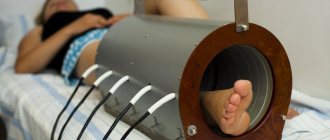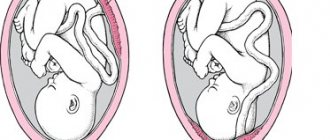Indications for amniocentesis
Amniocentesis during pregnancy has the following indications:
Diagnosis of congenital diseases. An invasive test is prescribed after an increased risk is identified during perinatal screening. Amniocentesis allows the collection of amniotic fluid containing cells with the fetal chromosome complement. After puncture, using modern equipment, doctors can determine genomic pathologies. Amniocentesis makes it possible to identify chromosomal abnormalities in the unborn child - Down syndrome (tripling of chromosome 23), Patau (tripling of chromosome 13), Edwards (tripling of chromosome 18), Turner (absence of one of the X chromosomes), Klinefelter (doubling of the X chromosome in boys).
Control of hemolytic disease of the fetus. This disease is observed in cases of Rh conflict associated with activation of the immune system of the expectant mother. Hemolytic disease of the fetus causes the breakdown of red blood cells, which are necessary for the respiration of all tissues. Amniocentesis allows you to count the amount of maternal antibodies in the amniotic fluid, thanks to which the doctor determines the severity of the disease.
Determination of the quality of lung tissue. Analysis of amniotic fluid during pregnancy allows you to calculate the amount of surfactant - a substance necessary for breathing atmospheric air. Indications for this study include diseases such as severe preeclampsia, placenta previa, and chronic renal failure.
Control of sterility of fetal fluid. Doctors prescribe amniotic fluid puncture after the mother has suffered a serious illness of bacterial or viral etiology - rubella, syphilis, toxoplasmosis.
Amnioreduction. This procedure is aimed at reducing the amount of amniotic fluid by puncturing it and releasing it from the uterine cavity. Amnioreduction is used to treat polyhydramnios.
Fetotherapy. Amniocentesis may be used to administer medications into the amniotic sac.
Why is amniotic fluid examined?
Amniotic fluid is the liquid medium that surrounds the unborn baby. It is the result of the secretion of the amnion (one of the embryonic membranes), consists of nutrients, hormones, vernix lubrication, elements of the epidermis and waste products of the fetus. Amniotic fluid participates in the metabolic processes of the unborn baby, protects it from infectious agents, noise and mechanical influences.
In addition, amniotic fluid is an important source of information about the condition of the fetus. The study of amniotic fluid allows us to identify malformations, which are divided into congenital and acquired. The former are inherited, the latter arise during the period of intrauterine development of the fetus.
Depending on the time of occurrence of defects, they can be divided into the following types:
- Gametopathies are changes in genetic material that occurred before/during fertilization of the egg or in the early stages of zygote cleavage.
- Blastopathies are pathologies formed in the first 15 days after fertilization.
- Embryopathies are disorders that appear during the formation of the embryo's main organs and systems.
- Fetopathies are diseases that arise from the 11th week of gestation until childbirth.
The division of fetal malformations into congenital and acquired is rather arbitrary. As a rule, most anomalies occur due to the influence of several factors.
In addition to hereditary factors, the cause of fetal pathologies can be:
- unfavorable environmental conditions;
- harmful working conditions for the expectant mother;
- alcohol, nicotine addiction in a pregnant woman;
- inflammatory processes of the genitourinary, digestive, respiratory and other systems;
- autoimmune diseases;
- illiterate use of medications during gestation.
Amniocentesis during pregnancy allows not only to diagnose disorders, but also to clarify their origin and make a prognosis for the life and development of the unborn child.
Online consultation with a gynecologist
consultation cost: from 500 rubles
Online consultation
During the consultation, you will be able to voice your problem, the doctor will clarify the situation, interpret the tests, answer your questions and give the necessary recommendations.
Dates
At the present stage of development of medicine, amniotic fluid puncture can be performed in any trimester of pregnancy. Early amniocentesis is prescribed from the 10th week of gestation. However, doctors may have difficulty performing it because the size of the uterus is too small. That is why it is preferable to perform late collection of amniotic fluid - after the 15th week of pregnancy.
The optimal time for amniocentesis to diagnose congenital fetal diseases is the period from 16 to 20 weeks of pregnancy. Puncture of amniotic fluid for other purposes is possible until the end of the gestation period.
Amniocentesis: when is it necessary and is the procedure safe for the fetus?
Possible complications
Amniocentesis during pregnancy is a procedure with potential risks.
| Amniotic fluid leak | Rarely, amniotic fluid leaks through the vagina after a fluid collection procedure. However, in most cases, the amount of fluid lost is small and stops within one week, and the pregnancy proceeds normally. |
| Miscarriage | Second trimester amniocentesis carries a small risk of miscarriage, ranging from 0.1 to 0.3%. Research shows that the risk of pregnancy loss is higher with screening done before 15 weeks of pregnancy. Most miscarriages occur within 3 days after the procedure. But in some cases this may happen after 2 weeks |
| Needle injury | During screening, the needle can hit vital organs of the fetus, but serious damage is extremely rare. |
| Spontaneous abortion | A pregnant woman with a negative Rh factor is given Rho-gamma globulin before the procedure to protect the child from her antibodies. In two cases out of a hundred, it is this drug that provokes a miscarriage. |
| Infection | In rare cases, infection of the uterus occurs during screening |
| Transmission of infection | If a woman is infected with hepatitis C, toxoplasmosis or HIV/AIDS infection, this can be transmitted to the child during the procedure. |
| Membrane damage | This can lead to bleeding and leakage of amniotic fluid, after which treatment can take up to several months. |
The invasive procedure rarely leads to serious complications, such as premature birth or inflammation of the amnion, the organ that provides water for the embryo to develop.
After amniocentesis is performed and the risks for the child are determined, a decision is made to terminate or continue the pregnancy. Only parents should do this. They can first consult with medical professionals and consider all the options for their decision.
Accuracy of amniocentesis
Amniocentesis is an invasive procedure, which is why it has a high accuracy of results in diagnosing congenital anomalies of the fetus - about 99%. During the procedure, cells from the unborn child are collected and examined directly. Direct diagnosis significantly reduces the likelihood of error compared to screening tests (ultrasound scanning and maternal biochemical blood tests).
The sensitivity of amniocentesis may decrease with the mosaic type of chromosomal abnormality - when some of the fetal cells have a normal genomic set. However, this type of pathology is rare, occurring in 0.1-1% of all congenital diseases.
The specificity of the diagnostic procedure in assessing surfactant maturation and the degree of hemolytic disease is also close to 100%. If the concentration of infectious agents in the amniotic fluid is low, amniocentesis may give a false negative result.
When is it held?
Purely personal decision
The very fact of carrying out such a diagnosis poses a very difficult question: can a couple love and raise a child with Down syndrome? Or another serious chromosomal abnormality?
It is this issue that is of paramount importance for the couple - it is even more important than the risk of amniocentesis, although insignificant, but still constituting real statistics - from 0.5 to 2% of miscarriages. Some people prefer not to ask this question at all, since they are ready for the role of parents in any case. Others prefer to have this information and raise the question of the future fate of this pregnancy.
The choice must be made by the Julias themselves; this question concerns only the two of them. Here the doctor can only offer options, but in no case apply pressure.
What do doctors suggest?
In Russia, amniocentesis is not included in the group of mandatory examinations. It is only prescribed if the pregnant patient is over 38 years old, since the risk of trisomy 21 increases with maternal age. The first time the doctor examines for trisomy 21 is during the first ultrasound, using a method to measure the permeability of the nuchal space. The second check is carried out between 14 and 18 weeks for amenorrhea - this is a blood test carried out on a voluntary basis. This is “determining the level of serum markers of trisomy 21” (MT21), that is, measuring the level of three “pregnancy hormones”. Based on the results, the doctor determines the risk level of the child having Down syndrome. But this analysis cannot give one hundred percent certainty. If the calculated risk is more than 1 in 50, the doctor suggests amniocentesis. Some cases of trisomy 21 were identified by comparing the results of measuring the permeability of the nuchal space and the level of serum markers in women under 38 years of age. For older women, this figure rises to 93%. If the patient is over 38 years of age, serum marker levels are determined only if the patient refuses amniocentesis.
Under what circumstances?
You may be advised to have an amniocentesis if you are over 38 years of age, if an ultrasound shows abnormalities, and if a blood test (serum level) shows the possible presence of an extra chromosome. Amniocentesis may also be recommended if the parents have a genetic or chromosomal disorder or if the first child has an extra chromosome (in France, under the above circumstances, the cost of the test is reimbursed by the main health insurance).
After 4 months (20 weeks of amenorrhea), amniocentesis can be prescribed as part of the monitoring of incompatibility between maternal and fetal blood groups (risk of hemolytic disease of the newborn); it allows you to determine the level of bilirubin (used to determine the degree of incompatibility) and prescribe appropriate therapy. In other situations, amniocentesis serves to determine the degree of intrauterine development of the fetus and to identify possible infectious diseases of the fetus.
Is there an alternative?
Currently, some groups of medical scientists are proposing to replace systematic amniocentesis in women over 38 years of age with screening for diseases in all pregnant women. Such a study consists of measuring the occipital region of the fetus during an ultrasound performed at the 12-13th week of amenorrhea, and a special test of the mother’s blood (serum levels). Based on the results of the tests, the doctor may prescribe amniocentesis if necessary. The purpose of this proposal is to reduce the number of analyzes and, accordingly, the consequences.
Contraindications
Amniocentesis should not be performed on certain groups of pregnant women:
#1. Threat of spontaneous abortion. Performing amniocentesis during increased uterine tone increases the likelihood of an unfavorable pregnancy outcome.
#2. Pathologies of the structure of the uterus. Congenital anomalies and tumor formations of the organ can cause difficulties during the procedure. In the worst case, amniocentesis provokes damage to the uterine wall.
#3. Acute inflammatory diseases. If there is a focus of infection in the expectant mother's body, during amniocentesis there is a risk of infection of the fetus.
Is it possible to avoid examination?
The procedure is impossible without the written consent of the expectant mother for the intervention and an explanation to her of all the features and risks of the study. However, she should know that if the doctor suggests doing amniocentesis, then it is really necessary. If the test results confirm the presence of a genetic disease or other congenital defect in the fetus, the doctor will help determine the further management of the pregnancy. In addition, he will tell you what kind of help the baby will need after birth and what difficulties the family will have to face.
Therefore, even if you decide not to undergo amniocentesis and accept your child anyway, keep in mind: knowing about the problems in advance, you can calmly prepare everything you need to meet him.
Risks of amniocentesis
When performed correctly and in the absence of contraindications, amniocentesis is a safe diagnostic test.
After amniocentesis, 1-2% of expectant mothers are at risk of leaking amniotic fluid for several days. This complication is a normal reaction of a woman’s body; it does not pose a threat to the life of the fetus. A woman’s body quickly replenishes the deficit of lost amniotic fluid.
If amniocentesis was performed more than 3 times, there is a possibility of amniotic membrane detachment. That is why doctors must control the frequency of invasive research methods and not prescribe them without compelling indications.
Failure to comply with the amniocentesis technique can lead to intrauterine infection of the fetus. The presence of disposable and sterile instruments prevents this complication.
If there is a Rh conflict, there is a possibility that the course of the disease will worsen due to amniocentesis. To prevent complications, doctors administer special drugs to expectant mothers that destroy antibodies.
Improper execution of the procedure can contribute to premature rupture of amniotic fluid and stimulation of labor. However, this complication is rare; it occurs only after a gross violation of the amniocentesis technique.
Aftercare treatments
After surgical procedures, a woman needs support:
- Physical care. During and immediately after the sampling procedure, a woman may experience dizziness, nausea, rapid heartbeat, and seizures. After the procedure, the woman goes home, where she needs to rest for 24 hours, having previously received instructions in case of complications.
- What is contraindicated:
- lift weights throughout the day;
- exercise for 24 hours;
- air travel within 72 hours.
- Emotional withdrawal. After the surgery is completed safely, the anxiety of waiting for test results can negatively impact a woman's well-being. At this point, she must receive emotional support from family and friends. Professional counseling may be necessary, especially if a fetal defect is detected.
As a rule, women after the procedure can begin their duties at work within 1 day.
Preparation
Amniocentesis is an invasive procedure that has certain contraindications and risks. That is why before the study, the woman undergoes a thorough diagnosis.
A few days before the amniotic fluid puncture, the expectant mother is sent to donate blood and urine for general tests. These studies help determine the presence of a source of infection in the body. For the same purposes, a pregnant woman should take a smear for vaginal flora.
The day before the procedure, a pregnant woman is advised to undergo an ultrasound examination. It is aimed at clarifying the duration of pregnancy, as well as determining the position of the placenta, the amount of amniotic fluid, the anatomical features of the structure and position of the uterus.
Preparation for the analysis includes taking antiplatelet drugs for 5 days before the proposed study of amniotic fluid. They are intended to prevent possible thrombus formation at the puncture site.
If amniocentesis is performed more than 20 weeks into pregnancy, the expectant mother should empty her bladder immediately before the procedure. If amniotic fluid puncture is prescribed at an earlier time, the woman needs to drink a liter of water an hour before the test.
During the consultation, the doctor informs the expectant mother about the rules for performing amniocentesis, the need to prescribe it, as well as possible risks and complications. After this, the woman must sign a consent to take a puncture of amniotic fluid. If desired, a pregnant woman can refuse the procedure.
Is it worth the risk?
Most often, after the examination, cramps are felt; you need rest and absence of any stress for 48 hours. In more rare cases, there is a loss of a small amount of amniotic fluid, and very rarely there is an infection or other complication that can cause a miscarriage, so amniocentesis is performed only when the information obtained is worth the risk.
Ultrasound helps doctors see the position of the fetus, so the chance of hitting it with a needle is negligible. The main negative side effect of amniocentesis is miscarriage, but this occurs in fewer than 1 in 200 women who undergo the test. In addition, after the procedure, 1% of women experience bleeding, cramps and discharge of amniotic fluid from the vagina. These symptoms usually go away on their own. Therefore, the overall risk of this procedure to you and your baby is quite low.
Carrying out
The entire procedure is carried out under ultrasound scanning control. It can be performed by an obstetrician-gynecologist who has undergone special training or retraining courses. The doctor selects a puncture site away from the fetus, umbilical cord and placenta in the area of the amniotic fluid pocket.
The puncture is carried out using a syringe equipped with a needle. Before the puncture, the mother's abdomen is treated with an antiseptic. The first 5-10 milliliters of amniotic fluid is drained because it contains the mother's cells and is not suitable for research.
For the test, the doctor takes about 25 milliliters of amniotic fluid, then removes the needle from the anterior abdominal wall. After this, the skin of the mother’s abdomen is re-treated with an antiseptic. A pregnant woman should remain in a lying position for 5 minutes.
Procedure step by step
The fluid is collected by a gynecologist in the operating room. It lasts about 20–25 minutes. During the procedure, ultrasound imaging is used to monitor needle position and fluid collection. After surgery, a woman may experience abdominal pain.
Spasms or slight discomfort in the pelvic area may occur. After some time, the doctor should monitor the fetal heart rate using ultrasound. In the postoperative period, the woman should be monitored to prevent uterine contractions.
There are two ways to carry out the procedure.
Free hand method
To obtain amniotic fluid, a puncture or amniocentesis is performed. The fluid is collected under the supervision of an ultrasonic sensor device, which selects the site of needle insertion. Initially, the thinnest place of the placenta, free from umbilical cord loops, is selected.
Before the procedure, the woman sits on a special table, and the doctor applies the gel to her stomach. Using an ultrasonic sensor, the puncture site is selected. The area is then cleaned with an antiseptic; an anesthetic is not always used. Guided by ultrasound, the doctor penetrates the abdominal wall into the uterine area.
A small amount of liquid, 15–20 ml, is withdrawn with a syringe, and then the needle is removed from the pregnant woman's body. A puncture is made into the found area with a thin needle with a diameter of 18–22 G. The duration of fluid collection is no more than 1–2 minutes.
Amniocentesis with puncture adapter
The difference between this technique and the first is that the puncture needle is fixed to the ultrasound sensor. The device draws a path along which the needle should pass. In this case, the doctor watches the passage of the needle on the monitor throughout the procedure. The method of collecting liquid remains the same as in the first case.
results
The extracted amniotic fluid is sent for cytological analysis to the laboratory. Specialists extract fetal cells from them, which are planted on nutrient media. This procedure is necessary to increase their number.
After obtaining a sufficient number of fetal cells, laboratory technicians conduct a genetic study. It includes counting the number of chromosomes, as well as determining markers of some hereditary diseases - cystic fibrosis, sickle defect of erythrocytes, etc.
Laboratory technicians also examine amniotic fluid for the presence of pathogens of infectious diseases. According to indications, specialists determine the amount of surfactant and maternal antibodies to fetal red blood cells.
The examination of amniotic fluid takes a certain period of time, usually taking about 7 working days to obtain results. The conclusion about the procedure contains information about the sex of the fetus, its genotype, and the number of chromosomes. It also indicates the detected pathogens, the titer of maternal antibodies and the degree of maturity of the fetal lungs.
After receiving the results, the expectant mother can know with almost one hundred percent probability whether the child has a congenital chromosomal abnormality. If the conclusion indicates a pathology of the fetal genome, the woman must decide whether to continue or terminate the pregnancy.
If maternal antibodies or infectious agents are detected in the amniotic fluid, further treatment tactics are discussed with the doctor. The specialist prescribes a course of therapy aimed at preventing pregnancy complications.
The amount of surfactant in the amniotic fluid is crucial in further decision-making in the presence of diseases that are a contraindication for prolongation of gestation.
What is the procedure?
When performing amniocentesis, hospitalization is not necessary. The study is carried out around the 15th week of amenorrhea.
Having sterilized the examination area, the doctor uses ultrasound to determine the location and location of the fetus and placenta. He then inserts a thin needle directly into the uterine cavity to withdraw 10-20 cm3 of amniotic fluid. The puncture lasts 1 minute and the degree of pain is comparable to taking blood from a vein. The material for analysis is sent to a special laboratory. The result is known after approximately 3 weeks.
How it's done
This is one of those tests that looks scary, but is actually not that painful and has few side effects. Some women are afraid of amniocentesis because during it a huge needle is inserted into the abdomen. They are worried about possible pain from inserting the needle or about possible harm to the baby and various complications. Others worry that there is a small risk of miscarriage. Most often, these fears are unfounded, and your doctor will recommend this test if the benefits outweigh the risks. There are no special instructions about eating or drinking before the procedure. You will lie on your back on the couch and the doctor will do an ultrasound to see what position your baby is in. After this, he will disinfect the stomach with an antiseptic solution. Many doctors do not use anesthesia because it is sometimes more painful than a quick prick with a thin needle. The doctor will insert a long, empty needle through your abdomen and into your uterus and amniotic sac to take a sample of the amniotic fluid. You will likely feel nothing more than a pinprick-like prick, followed by a feeling of tension or pressure as the needle moves forward. Amniotic fluid contains free fetal cells that can be grown in the laboratory; there, technicians will extract and analyze chromosomes and genes for various abnormalities. Most often, this analysis takes up to 2 weeks. The amount of amniotic fluid usually remains the same after 24 hours.
How is the analysis done?
Amniocentesis is carried out by taking a puncture from the uterine cavity of a pregnant woman. The analysis is carried out at 3 months of pregnancy (starting from the 14th week of amenorrhea). It is carried out under the control of echography (ultrasound), which makes it possible to clarify the age of the fetus, its location, as well as the location of the placenta. The process itself is not so much painful as it is exciting; in most cases, it passes without the use of local anesthesia, since anesthesia only involves an injection and only affects the skin layer. The procedure must be carried out under sterile conditions (absence of possible microbial pathogens) to avoid the slightest risk of infection. The test does not require hospitalization and takes only a few minutes. After taking the test, a two-day rest is required due to possible slight discomfort. The biggest threat that amniocentesis can cause is miscarriage due to cracks in the membrane. Even if the procedure went without violations, such consequences occur in 0.5-1% of cases.
Alternative options
Chorionic villus sampling is an alternative to amniocentesis in early pregnancy. This procedure can be carried out from the 9th week of gestation. The chorionic villus biopsy technique involves puncturing the tissues of the membranes through the vagina or anterior abdominal wall. This study helps determine the genotype of the unborn child and identify chromosomal abnormalities in the early stages of pregnancy.
Cordocentesis is a study that involves taking blood from the fetal umbilical cord using a puncture needle through the anterior abdominal wall. This procedure is carried out under ultrasound control no earlier than 18 weeks of pregnancy. The optimal time for cordocentesis is the middle of the second trimester. The study helps to identify congenital pathologies of the fetus, as well as the amount of hemoglobin, platelets, bilirubin and other substances in the blood of the unborn child.
Advantages and disadvantages
https://www.youtube.com/watch?v=BPtPY1x0ODM
Amniocentesis during pregnancy is a fairly common procedure in which candidates for testing are pregnant women over 35 years of age, or those who have had a screening test of maternal serum and identified chromosomal abnormalities.
There are certain risks associated with the procedure, so some women who clearly know that they would not want to terminate their pregnancy choose not to take the test.
Pros of amniocentesis:
- Screening can be used early in pregnancy to detect genetic defects in the fetus due to chromosomal disorders (Down syndrome), sex-linked defects (hemophilia), neural tube defects (such as spina bifida), inborn errors of metabolism (cystic fibrosis), and enzyme deficiency, for example Tay-Sachs disease.
- Amniotic fluid testing helps assess the maturity of the fetal pulmonary system by determining the lecithin/sphingomyelin (L/S) ratio, which measures surfactant levels in the fetal lung.
- Amniocentesis is used therapeutically to relieve hydramniosis (excessive amniotic fluid) and for intrauterine transfusion.
Disadvantages of the procedure:
- Complications are rare, but some can be serious. The placenta, fetus, or umbilical cord may be accidentally punctured, causing injury. Trauma, ranging from minor scratches on parts of the fetus to intrauterine hemorrhage, leads to distress and fetal death.
- Perforation of the placenta promotes hemorrhage from the fetal circulation, which can lead to fetal anemia or increased sensitization in the Rh-negative mother.
- Leakage of amniotic fluid through the vagina can increase the baby's risk of orthopedic problems, so the procedure is not recommended before the 15th week of pregnancy.
- Amniocentesis can cause the baby's blood to mix with the mother's blood. If the blood types do not match, then Rh immunoglobulin is prescribed to prevent the mother's blood from generating antibodies against the baby's blood cells.
Other dangers include induction of preterm labor and intra-amniotic infections.
Every woman, before agreeing to a test, must take into account the possible consequences and weigh the pros and cons. In addition, the test result cannot guarantee the birth of an absolutely healthy child; it only excludes some pathologies.
Its accuracy is about 99.4%. Therefore, every pregnant woman should consult a geneticist and only then make a final decision.
Indications for the study
The decision to use amniocentesis can only be made by a pregnant woman, since this procedure carries certain risks. And opinions differ on the feasibility of this study. First of all, you need to be prepared for the fact that if an anomaly is detected, you may have to terminate the pregnancy. However, early detection of a defect in a child will give time to find out what help may be needed.
And since amniocentesis poses some threat to the health of the mother and her child, this test is offered only to women who have significant prerequisites for the development of genetic diseases in the fetus, including in cases where:
- The ultrasound revealed a serious problem, such as a heart defect, which may indicate a chromosomal abnormality;
- According to the results of screening tests, there is a risk of having a baby with chromosomal abnormalities;
- One or more relatives of the woman and/or the father of the child have some genetic abnormality;
- A pregnant woman is over 35 years old, since from this age the risk of having a sick child increases - 1 case in approximately 300 (for comparison, at the age of a mother of 20 years this ratio is 1 in 2000).
- The woman already had a pregnancy with genetic abnormalities in the fetus.









